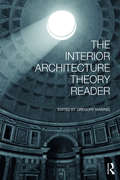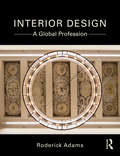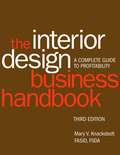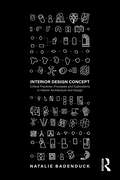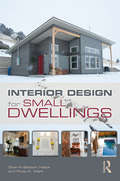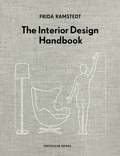- Table View
- List View
The Interior Architecture Theory Reader
by Gregory MarinicThe Interior Architecture Theory Reader presents a global compilation that collectively and specifically defines interior architecture. Diverse views and comparative resources for interior architecture students, educators, scholars, and practitioners are needed to develop a proper canon for this young discipline. As a theoretical survey of interior architecture, the book examines theory, history, and production to embrace a full range of interior identities in architecture, interior design, digital fabrication, and spatial installation. Authored by leading educators, theorists, and practitioners, fifty chapters refine and expand the discourse surrounding interior architecture.
The Interior Architecture Theory Reader
by Gregory MarinicThe Interior Architecture Theory Reader presents a global compilation that collectively and specifically defines interior architecture. Diverse views and comparative resources for interior architecture students, educators, scholars, and practitioners are needed to develop a proper canon for this young discipline. As a theoretical survey of interior architecture, the book examines theory, history, and production to embrace a full range of interior identities in architecture, interior design, digital fabrication, and spatial installation. Authored by leading educators, theorists, and practitioners, fifty chapters refine and expand the discourse surrounding interior architecture.
Interior decorating in nineteenth-century France: The visual culture of a new profession (Studies in Design and Material Culture)
by Anca I. LascThis book explores the beginnings of the interior design profession in nineteenth-century France. Drawing on a wealth of visual sources, from collecting and advice manuals to pattern books and department store catalogues, it demonstrates how new forms of print media were used to ‘sell’ the idea of the unified interior as a total work of art, enabling the profession of interior designer to take shape. In observing the dependence of the trades on the artistic and public visual appeal of their work, the book establishes crucial links between the fields of art history, material and visual culture, and design history.
Interior decorating in nineteenth-century France: The visual culture of a new profession (Studies in Design and Material Culture)
by Anca I. LascThis book explores the beginnings of the interior design profession in nineteenth-century France. Drawing on a wealth of visual sources, from collecting and advice manuals to pattern books and department store catalogues, it demonstrates how new forms of print media were used to ‘sell’ the idea of the unified interior as a total work of art, enabling the profession of interior designer to take shape. In observing the dependence of the trades on the artistic and public visual appeal of their work, the book establishes crucial links between the fields of art history, material and visual culture, and design history.
Interior Design: A Global Profession
by Roderick AdamsAs the globe shrinks and the concept of distance diminishes, this text challenges the current status quo by identifying the cohesions and specialisations of design communities across the continents. It sets out an international spatial design landscape, identifying and contouring global design practice and design hotspots from a range of case studies, interviews and design practice perspectives. Using a range of interior environments, the chapters link the origins, trends and perceptions of the interior to create new insight into trans-global design. The book expands, but also coheres the interior design discipline to ensure the subject continues to grow, develop and influence the inhabitations of the world. The book features a wealth of pedagogical elements including: Beautifully designed with over 100 full colour illustrations, photographs and examples of design work Maps and diagrams which highlight hotspots of design across the globe, providing strong graphic information Interview panels featuring professional insights from designers across the globe ‘Employability’ boxes, providing a good tips guide for students gaining employment across the globe ‘International Dimension’ boxes which strengthen the scholarship of studying interior design in a globalised way ‘Design Oddities’ box which brings into focus any new or contextual facts that help contextualise the global interior.
Interior Design: A Global Profession
by Roderick AdamsAs the globe shrinks and the concept of distance diminishes, this text challenges the current status quo by identifying the cohesions and specialisations of design communities across the continents. It sets out an international spatial design landscape, identifying and contouring global design practice and design hotspots from a range of case studies, interviews and design practice perspectives. Using a range of interior environments, the chapters link the origins, trends and perceptions of the interior to create new insight into trans-global design. The book expands, but also coheres the interior design discipline to ensure the subject continues to grow, develop and influence the inhabitations of the world. The book features a wealth of pedagogical elements including: Beautifully designed with over 100 full colour illustrations, photographs and examples of design work Maps and diagrams which highlight hotspots of design across the globe, providing strong graphic information Interview panels featuring professional insights from designers across the globe ‘Employability’ boxes, providing a good tips guide for students gaining employment across the globe ‘International Dimension’ boxes which strengthen the scholarship of studying interior design in a globalised way ‘Design Oddities’ box which brings into focus any new or contextual facts that help contextualise the global interior.
Interior Design And Identity (Studies In Design And Material Culture Ser.)
by Susie McKellar Penny Sparke Kim LathamThis fascinating collection provides a chronologically arranged set of case studies looking at how interior design has constantly redefined itself as a manifestation of culture, from the eighteenth-century to the present day. The book looks at the amateur activities of female 'home makers' in search of creative outlets and married couples seeking to modernise their homes as well as the contributions of early professional (female) 'interior decorators', and later, (male) 'interior designers'. It also considers the more anonymous role of commercial enterprises, such as hairdressing salons, ocean-going liners or modern offices as well as public institutions, such as hospitals or naval training establishments. Interior design and identity examines interior design in relation to the changing identities of its practitioners, its inhabitants and of the furnishings, focussing on the ways in which cultural values came to be embedded in the spaces which people inhabited and made their own. Issues relating to interiority, gender, and the relationship of the public sphere are also considered opening up a new level of design historical enquiry.
The Interior Design Business Handbook: A Complete Guide to Profitability
by Mary V. KnackstedtDiscover how you can run the practical side of your practice more profitably. This comprehensive guide to managing an interior design business gives you an arsenal of proven procedures and practical tools and techniques perfected over the course of some thirty years. New to this edition are sections on establishing an electronic office, the pros and cons of working alone and creating partnerships, hiring and working with off-site employees, and more. It also includes more than fifty sample forms and letters, such as an existing conditions survey and a letter of transmittal, that can easily be adapted to your own uses.
The Interior Design Business Handbook: A Complete Guide to Profitability
by Mary V. KnackstedtThousands of interior design professionals have come to rely on The Interior Design Business Handbook for comprehensive, accessible coverage of the essential procedures, tools, and techniques necessary to manage a successful interior design business. The Fifth Edition of this essential resource has been revised to address the latest trends and changes in the field, with new and updated material on business size and structure, building a brand, client development, social networking and Internet marketing, finances, purchasing, technology and software programs, and other key areas. Complete with more than 75 sample forms and letters, this Fifth Edition is a one-stop resource for all aspects of establishing and running an interior design business—from choosing a location and managing day-to-day operations to growing a business and putting it up for sale. All of the techniques and procedures in the book are rooted in real-world experience and are used daily in successful design firms throughout the United States. Filled with valuable information for solo practices and small firms as well as larger businesses, this book is an indispensable resource for seasoned professionals as well as interior designers who are at the start of their career.
The Interior Design Business Handbook: A Complete Guide to Profitability
by Mary V. KnackstedtThousands of interior design professionals have come to rely on The Interior Design Business Handbook for comprehensive, accessible coverage of the essential procedures, tools, and techniques necessary to manage a successful interior design business. The Fifth Edition of this essential resource has been revised to address the latest trends and changes in the field, with new and updated material on business size and structure, building a brand, client development, social networking and Internet marketing, finances, purchasing, technology and software programs, and other key areas. Complete with more than 75 sample forms and letters, this Fifth Edition is a one-stop resource for all aspects of establishing and running an interior design business—from choosing a location and managing day-to-day operations to growing a business and putting it up for sale. All of the techniques and procedures in the book are rooted in real-world experience and are used daily in successful design firms throughout the United States. Filled with valuable information for solo practices and small firms as well as larger businesses, this book is an indispensable resource for seasoned professionals as well as interior designers who are at the start of their career.
Interior Design Concept: Critical Practices, Processes and Explorations in Interior Architecture and Design
by Natalie BadenduckInterior Design Concept combines a comprehensive introduction to design concept, with a reflective examination upon the various ways it can be understood, harnessed, and implemented. Within interior architecture and design, the power of conceptual thinking to fuel creativity, innovation, and collaboration is evident in the use of design concept. Broadly accepted as an essential component in the design process, design concept is a notoriously elusive topic which has, until now, received little critical attention. This book offers a reevaluation of current academic ideas about design methodologies and the nature of inspiration, alongside brand-new data from an international research study to help clarify what creativity really means in the modern world. Topics addressed throughout this text will examine the functions and definitions of design concept, analyze how it may be identified and integrated within the design process, investigate from where ideas for design concepts can emerge and, lastly, consider how ideas about them might be communicated in various ways. This book offers students, educators, and practitioners a concise explanation of what design concept is, why it plays such an integral role in the design process, and how it is utilized by interior architects and designers.
Interior Design Concept: Critical Practices, Processes and Explorations in Interior Architecture and Design
by Natalie BadenduckInterior Design Concept combines a comprehensive introduction to design concept, with a reflective examination upon the various ways it can be understood, harnessed, and implemented. Within interior architecture and design, the power of conceptual thinking to fuel creativity, innovation, and collaboration is evident in the use of design concept. Broadly accepted as an essential component in the design process, design concept is a notoriously elusive topic which has, until now, received little critical attention. This book offers a reevaluation of current academic ideas about design methodologies and the nature of inspiration, alongside brand-new data from an international research study to help clarify what creativity really means in the modern world. Topics addressed throughout this text will examine the functions and definitions of design concept, analyze how it may be identified and integrated within the design process, investigate from where ideas for design concepts can emerge and, lastly, consider how ideas about them might be communicated in various ways. This book offers students, educators, and practitioners a concise explanation of what design concept is, why it plays such an integral role in the design process, and how it is utilized by interior architects and designers.
Interior Design: Conceptual Basis
by Anthony SullyMaximizing reader insights into interior design as a conceptual way of thinking, which is about ideas and how they are formulated. The major themes of this book are the seven concepts of planning, circulation, 3D, construction, materials, colour and lighting, which covers the entire spectrum of a designer’s activity. Analysing design concepts from the view of the range of possibilities that the designer can examine and eventually decide by choice and conclusive belief the appropriate course of action to take in forming that particular concept, the formation and implementation of these concepts is taken in this book to aid the designer in his/her professional task of completing a design proposal to the client. The purpose of this book is to prepare designers to focus on each concept independently as much as possible, whilst acknowledging relative connections without unwarranted influences unfairly dictating a conceptual bias, and is about that part of the design process called conceptual analysis. It is assumed that the site, location, building and orientation, as well as the client’s brief of activities and needs have been digested and analysed to provide the data upon which the design process can begin. Designed as a highly visual illustrative book, as the interior design medium demands, the hands-on creative process of designing is detailed with original drawn illustrations. Concentrating on the conceptual process of designing interiors, and defining what these concepts are, this book will help the designer to organise his/her process of designing and to sharpen the links between the various skill bases necessary to do the job. This book will be stimulating for students and instructors alike and is aimed at any student who maybe majoring in interior design, interior architecture, architecture, design thinking or furniture design. It could also be a useful reference for students of design management and design leadership.
Interior Design for Autism from Adulthood to Geriatrics (Wiley E-book Design Shorts)
by A. J. Paron-WildesWhen designing spaces for individuals with Autism, there are specific design strategies that can be employed to create optimal spaces that can have a positive impact on special learning and sensory needs. Interior Design for Austism from Adulthood to Geriatrics gives designers the exact information they need to implement these design strategies in their own projects. Projects covered relate specifically to the age ranges from adulthood through geriatric age, including workplaces, clinical settings, and nursing homes. The main neurofunctions of Autism are covered along with specific design techniques that can be used to address each one. Information on toxins and material selection is also included.
Interior Design for Autism from Adulthood to Geriatrics (Wiley E-book Design Shorts)
by A. J. Paron-WildesWhen designing spaces for individuals with Autism, there are specific design strategies that can be employed to create optimal spaces that can have a positive impact on special learning and sensory needs. Interior Design for Austism from Adulthood to Geriatrics gives designers the exact information they need to implement these design strategies in their own projects. Projects covered relate specifically to the age ranges from adulthood through geriatric age, including workplaces, clinical settings, and nursing homes. The main neurofunctions of Autism are covered along with specific design techniques that can be used to address each one. Information on toxins and material selection is also included.
Interior Design for Autism from Birth to Early Childhood (Wiley E-book Design Shorts)
by A. J. Paron-WildesInterior Design for Austism from Birth to Early Childhood gives designers who are creating spaces for individuals with Autism, the exact information they need to create optimal spaces that can have a positive impact on special learning and sensory needs. This book also shows how to implement specific design strategies that can be employed in their own projects. Projects covered relate specifically to the age ranges from birth through early childhood, including schools, homes, and clinical therapy settings. The main neurofunctions of Autism are covered along with specific design techniques that can be used to address each one. Information on toxins and material selection is also included.
Interior Design for Autism from Birth to Early Childhood (Wiley E-book Design Shorts)
by A. J. Paron-WildesInterior Design for Austism from Birth to Early Childhood gives designers who are creating spaces for individuals with Autism, the exact information they need to create optimal spaces that can have a positive impact on special learning and sensory needs. This book also shows how to implement specific design strategies that can be employed in their own projects. Projects covered relate specifically to the age ranges from birth through early childhood, including schools, homes, and clinical therapy settings. The main neurofunctions of Autism are covered along with specific design techniques that can be used to address each one. Information on toxins and material selection is also included.
Interior Design for Autism from Childhood to Adolescence (Wiley E-book Design Shorts)
by A. J. Paron-WildesWhen designing spaces for individuals with Autism, there are specific design strategies that can be employed to create optimal spaces that can have a positive impact on special learning and sensory needs. Interior Design for Autism from Childhood to Adolescence gives designers the exact information they need to implement these design strategies in their own projects. Projects covered relate specifically to the age ranges from childhood through adolescence, including high schools, residential group homes, and workplaces. The main neurofunctions of Autism are covered along with specific design techniques that can be used to address each one. Information on toxins and material selection is also included.
Interior Design for Autism from Childhood to Adolescence (Wiley E-book Design Shorts)
by A. J. Paron-WildesWhen designing spaces for individuals with Autism, there are specific design strategies that can be employed to create optimal spaces that can have a positive impact on special learning and sensory needs. Interior Design for Autism from Childhood to Adolescence gives designers the exact information they need to implement these design strategies in their own projects. Projects covered relate specifically to the age ranges from childhood through adolescence, including high schools, residential group homes, and workplaces. The main neurofunctions of Autism are covered along with specific design techniques that can be used to address each one. Information on toxins and material selection is also included.
Interior Design for Small Dwellings
by Sherrill Baldwin Halbe Rose K MarkInterior Design for Small Dwellings addresses the onrush of interest in smaller homes and the possibility that small dwellings might be the answer to housing needs and sustainability. The book explores key principles essential to residing and designing small interiors with emphasis on client involvement and implementation of participatory, inclusive design as advocated by the Council for Interior Design Accreditation. Does living in a small space mean living small? The authors believe that by simplifying one’s life intelligently and applying certain principles of design, planning and organization, one can actually live a meaningful life in a smaller space. These tenets are based on the authors’ professional experiences and living in small homes. To this end, the book provides discussion, images, case studies, interviews, worksheets, activities and suggested explorations. Interior Design for Small Dwellings is a teaching guide and provides information and exercises that help professional designers utilize design theory, space planning and programming techniques. Throughout, the text affords sustainability, biophilic design and wellness methodologies.
Interior Design for Small Dwellings
by Sherrill Baldwin Halbe Rose K MarkInterior Design for Small Dwellings addresses the onrush of interest in smaller homes and the possibility that small dwellings might be the answer to housing needs and sustainability. The book explores key principles essential to residing and designing small interiors with emphasis on client involvement and implementation of participatory, inclusive design as advocated by the Council for Interior Design Accreditation. Does living in a small space mean living small? The authors believe that by simplifying one’s life intelligently and applying certain principles of design, planning and organization, one can actually live a meaningful life in a smaller space. These tenets are based on the authors’ professional experiences and living in small homes. To this end, the book provides discussion, images, case studies, interviews, worksheets, activities and suggested explorations. Interior Design for Small Dwellings is a teaching guide and provides information and exercises that help professional designers utilize design theory, space planning and programming techniques. Throughout, the text affords sustainability, biophilic design and wellness methodologies.
Interior Design Fundamentals: - with STUDIO
by Steven B. Webber"The book's greatest strength is approaching the subject through the lens of design thinking. There is a need to emphasize design thinking at early foundation levels in interior design." Lee Keen, Louisiana State University, USALearn the basics of interior design, design thinking, and the design process. Envision yourself in the role of professional designer as you learn about design phases, spatial well-being, color theory, professional practice, finishes, furnishings, lighting, environmental systems, and more. Case studies, review questions, and exercises in every chapter will help you see how the topics will affect your career.Features -Provides techniques for developing awareness of conditions related to urban and rural issues, building architecture, and societal and organizational cultures -Case Studies showing how designers address important topics like homelessness and adaptive reuse, as well as use color, furniture, materials, lighting, and environmental support systems to reflect the client's message -Learning objectives and outcomes, definitions of key terms, review questions, chapter summaries, and exercises reinforce the learning experience Instructor's Resources -Instructor's Guide provides suggestions for planning the course and using the text in the classroom, supplemental assignments, and lecture notes -Test Bank includes sample questions for each chapter -PowerPoint® presentations include images from the book and provide a framework for lecture and discussion PLEASE NOTE: Purchasing or renting this ISBN does not include access to the STUDIO resources that accompany this text. To receive free access to the STUDIO content with new copies of this book, please refer to the book + STUDIO access card bundle ISBN 9781501327087.
The Interior Design Handbook: Furnish, Decorate, And Style Your Space
by Frida RamstedtTHE BESTSELLING SWEDISH PHENOMENONWhat looks good and why?Design consultant Frida Ramstedt runs Scandinavia's leading interior design blog. In this book she distils the secrets of successful interior design and styling to help you create a home that works best for your space, taste and lifestyle. Filled with practical tips, rules-of-thumb and tricks of the trade, The Interior Design Handbook will help you to think like a professional designer.
Interior Design Illustrated
by Francis D. Ching Corky BinggeliThe bestselling guide to interior design, updated with new code and technology Interior Design Illustrated is the definitive guide to design for interior spaces. Richly illustrated in author Francis Ching’s signature style, this book introduces complex design concepts in a visually stunning format; from defining the space and using the elements of design, to planning building systems and incorporating sustainable materials, this volume embodies the idea that beauty and function are not separate entities, but two parts of a whole. This new fourth edition has been updated to reflect the latest building codes and design practices, with discussion of new materials related to acoustics, lighting, and sustainable furnishings. Renewed attention to sustainability includes new information on energy conservation, design for longevity and adaptive reuse of existing buildings, as well as an updated discussion on LED lighting, workplace design, use of color, and computer modeling software to provide a well-rounded view of how interior design firms are working today. This classic text brings the elements and principles of design to life, giving students the practical skills they need to transition from idea to concept. Understand the latest building codes and how to integrate them into your design Explore new advances in materials, lighting, and wireless technology Design from a perspective of sustainability, longevity, and energy efficiency Delve into BIM, including software for modeling lighting, acoustics, and more Interior designers work at the intersection of aesthetics, functionality, regulations, accessibility, sustainability, and technology. There’s no one formula for getting it right, only an eye trained by experience, based on a mastery of design fundamentals. Interior Design Illustrated begins laying that foundation, guided by a leading global authority in the field.
Interior Design Illustrated
by Francis D. Ching Corky BinggeliThe bestselling guide to interior design, updated with new code and technology Interior Design Illustrated is the definitive guide to design for interior spaces. Richly illustrated in author Francis Ching’s signature style, this book introduces complex design concepts in a visually stunning format; from defining the space and using the elements of design, to planning building systems and incorporating sustainable materials, this volume embodies the idea that beauty and function are not separate entities, but two parts of a whole. This new fourth edition has been updated to reflect the latest building codes and design practices, with discussion of new materials related to acoustics, lighting, and sustainable furnishings. Renewed attention to sustainability includes new information on energy conservation, design for longevity and adaptive reuse of existing buildings, as well as an updated discussion on LED lighting, workplace design, use of color, and computer modeling software to provide a well-rounded view of how interior design firms are working today. This classic text brings the elements and principles of design to life, giving students the practical skills they need to transition from idea to concept. Understand the latest building codes and how to integrate them into your design Explore new advances in materials, lighting, and wireless technology Design from a perspective of sustainability, longevity, and energy efficiency Delve into BIM, including software for modeling lighting, acoustics, and more Interior designers work at the intersection of aesthetics, functionality, regulations, accessibility, sustainability, and technology. There’s no one formula for getting it right, only an eye trained by experience, based on a mastery of design fundamentals. Interior Design Illustrated begins laying that foundation, guided by a leading global authority in the field.
